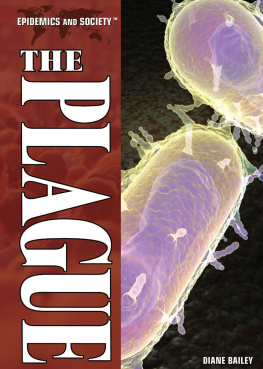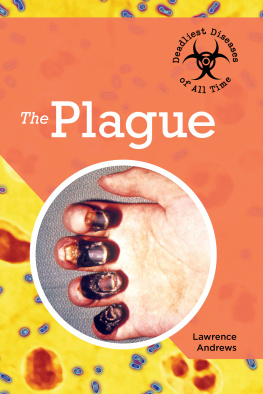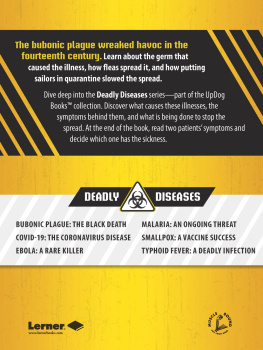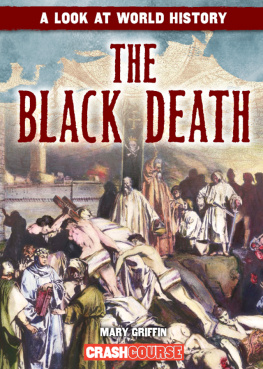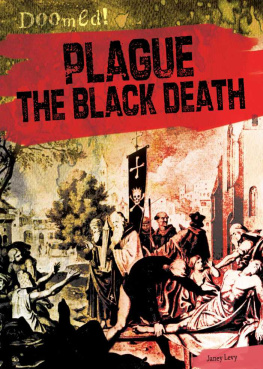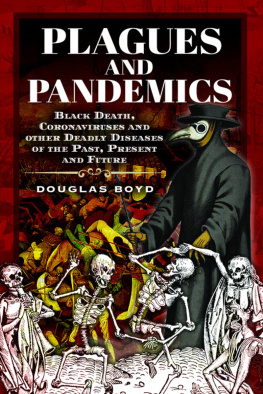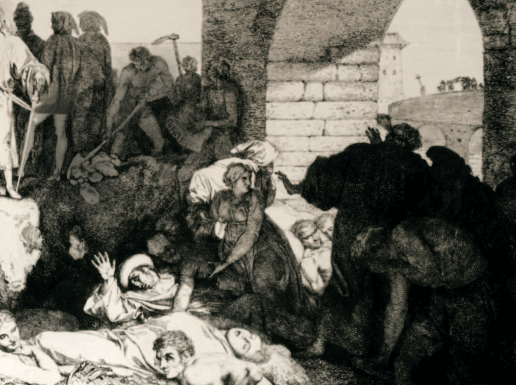Published in 2011 by The Rosen Publishing Group, Inc.
29 East 21st Street, New York, NY 10010
Copyright 2011 by The Rosen Publishing Group, Inc.
First Edition
All rights reserved. No part of this book may be reproduced in any form without permission in writing from the publisher, except by a reviewer.
Library of Congress Cataloging-in-Publication Data
Bailey, Diane, 1966
The plague / Diane Bailey. 1st ed.
p. cm. (Epidemics and society)
Includes bibliographical references and index.
ISBN 978-1-4358-9435-8 (lib. bdg.)
1. PlagueJuvenile literature. I. Title.
RC171.B295 2011
614.5'732dc22
2009046614
Manufactured in the United States of America
CPSIA Compliance Information: Batch #S10YA: For further information, contact Rosen Publishing, New York, New York, at 1-800-237-9932.
On the cover: The bacteria that causes the plague.
CONTENTS
CHAPTER 1
The Pestilence
CHAPTER 2
The three Pandemics
CHAPTER 3
Desperate times
CHAPTER 4
Rebuilding Society
CHAPTER 5
Prelude to the renaissance
CHAPTER 6
A Modern threat?
INTRODUCTION
F or a few horrible years, the streets of medieval Europe were filled with the sounds of death. People moaned in pain and wailed with grief. Church bells tolled for the dead. And carts rattled on the cobblestones as they carried away the bodies.
As plague gripped Europe in the middle of the fourteenth century, the normal business of living was replaced by the grisly spectacle of dying. Hundreds, then thousands, and eventually millions of people fell ill. People died in their homes and at their businesses. Sometimes they literally dropped dead in the streets.
Traditionally, when someone died, there was an elaborate ceremony. A priest led the mourners as they carried the deceased person from his or her house to the cemetery. In the time of plague, this tradition collapsed. There were not enough casketsthe coffin makers could not keep up. There were not enough priests to hold the funerals. There were not enough places to bury the dead. Sometimes, there were not even enough people left to mourn.
An engraving by Italian artist Luigi Sabatelli illustrates the nightmare of plague in Florence, Italy. Cities and villages collapsed into chaos as people died, filling the streets with corpses.
Burials became nothing more than terrible chores. Men pushed carts through the streets and called out a grim order: Bring out your dead. Families of those who had died in the night would then carry out the bodies and place them on the carts.
Collecting the dead was a horrible job that few wanted. Agnolo di Tura, an Italian man who lived during the plague, wrote, No one could be found to bury the dead for money or for friendship. Many were afraid they would catch the pestilence from the bodies of the dead.
Anyone who would do the job was hiredincluding criminals. The becchini (gravediggers) in Florence, Italy, had a bad reputation. Florence was particularly hard-hit by the plague, but the becchini laughed in the face of death. While others mourned, they partiedand worse. They robbed and even murdered helpless people. There was no one to stop them. Sometimes they would burst into peoples houses and demand money not to take people who were still alive.
The cemeteries filled up. New ones were built to keep up with the piles of bodies that grew each day. Even that was not enough. Soon, bodies were simply dumped into large plague pits. However, Christians were concerned with getting a proper funeral that would guarantee they went to heaven. To fulfill this spiritual need, Pope Clement VI blessed the entire Rhone River, making it sacred. Bodies were then put into the river and floated out to the Mediterranean Sea.
The plague raged through the Mediterranean, into Italy, France, England, and northern Europe. Before it stopped, it killed twenty-five million peopleabout a third of the continents population. Some modern historians think the number could have been as high as fifty million60 percent of the population.
History is made by people. Usually, they make it by what they do in their lifetimes. But in the case of the plague, history was made by death. The horrible toll of the plague changed the face and fabric of Europe forever.
CHAPTER 1
THE PESTILENCE
R umors floated in from traders and sailors. A strange, terrible disease was moving through the Mediterranean. The people who got it suffered from extreme pain. Then, they passed the sickness to others. Worst of all, they died. The pestilence seemed to strike down nearly everyone it touched.
People who lived in Europe in the mid 1300s probably didnt know what to make of these stories. At first, they probably did not worry too much about a disease that killed faraway people. Perhaps they thought it would not affect them. They would be wrong. Within months of those first frightening reports, the pestilence was moving northinto the heart of Europe.
A Disease of Rodents
Plague did not start out as a human disease. It began in rodents. Marmots, a type of large squirrel in Asia, were probably the first to get it. Rats, prairie dogs, and other rodents got the disease, too.
The plague is caused by a bacterium called Yersinia pestis. It evolved out of an ancient bacterium that caused stomach flu symptoms but was ultimately not fatal. However, the plague bacterium was ambitious. It evolved into an efficient killer.
These bacteria live in fleas, which in turn live on rodents. People dont feel much sympathy for sick fleas, but fleas infected with plague suffer, too. Fleas survive by feeding on their hosts (the animals they live on). They bite their hosts, taking in a small amount of blood each time. The plague bacteria interfere with this process. The bacteria block the fleas stomach so it never feels full. The hungry flea keeps eating. However, there is nowhere for the blood to go. The flea then spits the blood back into the wound made by its bite. Along with the blood comes a few plague bacteria. Now the fleas host animal is also infected. Plague is not always transmitted through blocked fleas. Some fleas can spread it just by having the bacteria on their mouths.
Making the Leap
In medieval Europe, people were surrounded by garbage. In cities, people lived extremely close together. The streets were filled with human and animal waste. People did not know how to effectively get rid of it. (In many cases, good sanitation only meant warning people on the street before dumping a bucket of slop out the window.) People were certainly aware of the ick factor. However, they did not fully understand that waste could actually be dangerous. The garbage attracted ratsand their fleas carried the plague.
A magnified picture of a diseased flea shows its body filled with the blood it sucked from a mouse. The plague bacteria makes fleas spit infected blood back into their victims, spreading the disease.
It was a disgusting place, but not to rats. Rats liked what humans rejected. The amount of waste grew. So did the number of rats who were attracted to it. When these rats became infected with plague, it was only a matter of time before it spread to humans.

